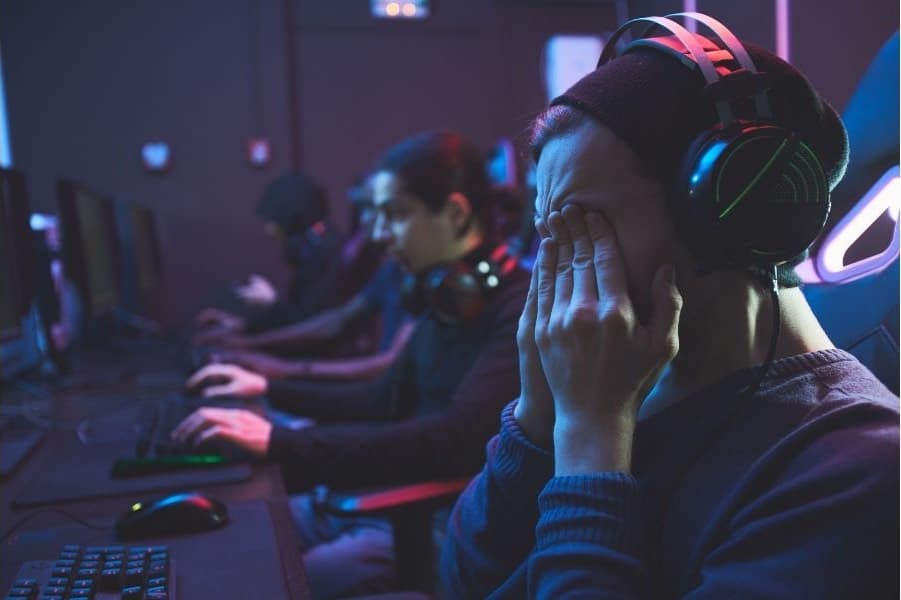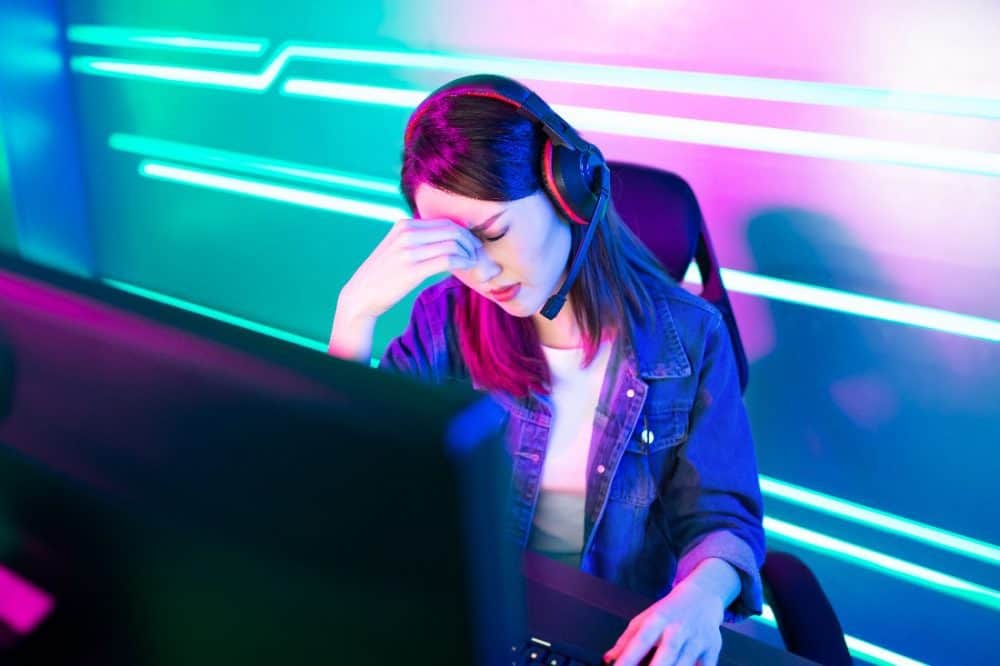
You've probably heard that sitting in front of a computer monitor for too long can lead to eye strain. This is because monitors emit blue light, which can really hurt your eyes if you don't take enough breaks. But are gaming monitors bad for your eyes? Today we'll look at the different types of monitors and how they affect our vision.
What is Eye strain from monitors?
Eye strain is the term for any type of pain, fatigue or discomfort you get from looking at your monitor too long.
Some newer research suggests that prolonged exposure to computer screens causes eye strain in many users. But before we get into what “eye strain” means let's talk about how often we're looking at our digital screens (as well as other devices) these days.
Apple found in their US users’ screen time statistics that generation X and Baby boomers spend about 169 minutes and 136 minutes on their phones repectively. And other statistics from studies show that children and teens are spending 4 hours or more on electronic devices.
Eye Strain is one thing but many people argue that the blue light emitted by these type of screens, including computer monitors, could also have an effect on your eyesight over time. This is because they reduction melatonin production need for inducing sleep (in some cases) and disrupt circadian rhythms with their relatively high intensity light stimulus near bedtime.
Eye strain is often caused by extended periods of looking at a computer monitor, which can tire the muscles around your eyes. This condition causes blurry vision and headaches in some people.
Eye-strain symptoms are generally temporary but may happen again if you don't give your eyes time to relax from digital devices or try an alternate work environment for awhile (like reading a book)
The prolonged tension can come from too much time spent in front of a screen with insufficient breaks - that's even true if you're taking regular short breaks to rest your eyes and neck.
If you are experiencing eye strain it can manifest as:
- Headaches, blurred vision
- Dry eyes
- Sensitivity to light (photophobia)
- Redness around the eyes (conjunctivitis)
- General feelings of discomfort like nausea or dizziness.
- Allergies may also play a role in eye strain.
It's also not uncommon for people who have certain allergies to develop symptoms when they work on screens all day such as: sneezing, a runny nose, shortness of breath and wheezing.
Are gaming monitors bad for your eyes?
A lot of people seem to think that the answer is “yes”, but it's actually a little more complicated than that. Although many gamers swear that they’ve never had problems with eye damage.
It also depends on how you use the monitor, what type of monitor it is, and if there are any eye-related problems like myopia or astigmatism.
If you're not sure whether your current monitor is causing enough strain you can take this quick test online (and if it works for you when sitting down then keep reading).
People also tend to blink less when using devices, which contributes dry eye and eye strain. And because computer screens tend to emit a lot of blue light, this unfocused visual "noise" reduces contrast and can contribute to digital eye strain.
Professional eSport gamers also need to manage their blue light and eye-strain exposure, particularly because they are playing in front of a screen for hours on end.
Gaming monitors are less likely to have blur and ghosting, because they have higher refresh rates than regular displays. For gamers specifically, the most important advantages to gaming monitors are speed and frame rates (how many frames per second are being shown). These days 144hz monitors have become more mainstream, as they provide an excellent balance between smoothness without input lag; even better than 60Hz displays which are still considered a competitive standard.
The best way to figure out if gaming monitors are bad for your eyes is to see an optometrist about it first! Most people who do this find that when using some types of displays, such as LCDs with lower resolutions and less amount of blue light, are easy on the eyes.
Are higher refresh rates like 144hz and above monitors bad for your eyes?
It's important to note that monitors in general actually aren't bad for your eyes, they're just different from one another.
Monitors with higher refresh rates (like 144hz) are easier on the eyes than those without them because of things like reduced blurring effects...and at the same time with less motion blur it makes movies, gaming and other video content better looking as a result.
But higher refresh rates might not be the only thing in the equation for eye fatique and damage. Most people may find that when using some types of displays, such as LCDs with lower resolutions and less amount of blue light, are easier on the eyes.
How can you avoid the negative effects of gaming monitors

There are some detrimental effects of gaming monitors, particularly for your eyes. It can lead to eye strain, headaches and other health issues.
You should make sure that your screen is at a comfortable viewing distance from you so there's no glare or squinting.
You need an anti-glare monitor if you're going to be in direct sunlight all day but these are expensive for the high quality ones, so make sure they have one before purchase!
Wearing computer glasses (buy from Amazon) while gaming can also assist in minimizing eye strain by blocking blue light from digital screens.
In addition, it’s important to take regular breaks from looking at screens (yes this includes tablets!) as well as giving your eyes some rest while playing games by dimming the lights or turning off the TV/monitor entirely every once in awhile.
You should make sure that your screen is at a comfortable viewing distance from you so there's no glare or squinting.
The key to preventing eye strain is taking regular breaks from looking at screens - even if you're not feeling any symptoms yet. We recommend setting an alarm for every 20 minutes or so spent in front of your monitor screen, and then spending atleast five minutes away from it.
How does the backlight work on a gaming monitor?
The backlight on a monitor is an important factor in determining how good or bad it will be for your eyes. The brighter the screen, the harder its going to be on your eyes if you're looking at it all day - and some monitors actually have brightness settings that are too high out of the box!
To make sure that this isn't happening, take a look at what type of backlight the monitor has before buying one. A LED backlit display should offer more eye relief than an older CCFL-backlit model because LEDs produce less light around their edges than Cold Cathode Fluorescent Lamps (CCFLs).
If you buy a gaming monitor with AMD FreeSync enabled technology then things might be different as they have a dynamic backlight that adjusts to the changing light of your surroundings - and this can make it easier on your eyes.
This is because the monitor will have less brightness fluctuations when you're playing games or watching movies than a standard LCD display with its static backlight.
But what about color?
What about color? Well, it's unclear how much of a difference in eye strain there might be when looking at different colors. Some research even suggests that yellow screens can help minimize eyestrain from computer monitors. But whether you are working late or playing games for hours on end make sure to take breaks and blink often! And if things get so bad you need glasses then try wearing them while gaming too.
Do you need to calibrate your monitor for games?
Calibrating your monitor might help with eye strain when gaming.
There are a few ways you can calibrate your monitor and the easiest is to download an app like DisplayCAL on PC, or use the built-in display calirator for Mac.
These will walk you through all of the steps necessary to get your colors looking just right - whether it's getting them calibrated with sRGB or white point set correctly.
The problem with this approach though is that if you don't keep those settings up-to-date then they could quickly become out of date which might lead to eye strain when playing games as incorrect color profiles can affect how we see things differently than intended by developers.
If you're asking about whether it is necessary to calibrate for gaming, then that really depends on how much time and effort you are willing to put into tweaking things. If all of this sounds tedious and boring then just press "auto" instead of doing anything else - most monitors do a good job at self-calibration these days anyway.
Video - Eye strain and computer vision syndrome
Are gaming monitors better for your eyes?
Gaming monitors can help with eye strain because they generally have a higher resolution (less pixels per inch) which means there isn't as much strain on the eye to try to read them! And any monitors you'll use will likely have at least a little bit of blue light so anti-reflective coating can help reduce glare from ambient lighting too.
You might also want to consider upgrading because some new models now have built-in filters or features like eye-care for blue light reduction and flicker free technology. These might help relieve eyestrain symptoms by minimizing how often blue light flashes in front of our eyes on screen.
Gaming monitors also tend to have a higher refresh rate than regular computer screens (which makes them better), but these can also emit more blue light - so whether they're good or not really depends on factors outside of just their specifications.
There are also some gaming monitors that have lower levels of blue light and therefore better for your eyes. They often refer to this feature as "eye care".
The best thing you can do though, for both your eye and gaming needs, is to take regular breaks (every 20 minutes or so!) because it gives your eyes time to rest and process what they're seeing on screen before returning back to the game.
What type of gaming monitor is easiest on the eyes?
The higher DPI (dots per inch) the better for your eye health, as well! Why not get something that's going to be good for both of these things: quality images and healthy outdoor habits?
The best monitors for gaming are those that have a higher DPI (dots per inch) which is what most screens warrant today as they're more efficient and take less power to light up than their counterparts, like CRT or LCD displays!
The monitor with better quality will win out every time because then you can see further without eye strain! With these types of monitors, there won't be any worries about eyestrain from sitting so close to the screen for longer periods of time - even while playing games!
This means that at night when you start watching TV, staring at your computer monitor...you'll feel less fatigue and eyestrain than if you were to stare at an LCD or CRT! The monitor also has a higher refresh rate.
If you want even more eye relief from gaming monitors then go for one with VA panel technology as they are known to be better for long-term viewing thanks to their deeper blacks which help keep an image's contrast high while keeping things looking pleasingly dark.
And then you also get monitors with eyecare technology as an added benefit.
Eye Care monitors
So called "Eye care" monitors are a newer technology that is actually a marketing gimmick. In truth, these monitors are the same as any other monitor on the market today. The only difference with an "eye care" monitor is that it has a lower blue light output and can provide more eye relief in certain colors from being used for extended periods of time; however, this doesn't mean they're better than other screens!
Benq in particular is fairly known for their eye-care monitors. If your gaming monitor is causing too many problems for your eyes then try using something like BenQ Eye-Care Monitor to help reduce eye strain.
Its backlit technology means it has less glare than others so your eyes won’t tire out as much while playing games. It also comes with flicker free technology that reduces any potential eyestrain from screens.
Video - Can this monitor help the eyes
Best gaming monitors for reducing eye strain
BenQ EW3280U gaming monitor with eyecare technology
[Best blue light reduction]
BenQ's EW3280U 32inch gaming monitor with eyecare technology is perfect for gamers that want uninterrupted movement during their game sessions, while making it easy to browse through web pages at the same time too.
With 4k resolution and a refresh rate of 144Hz that offers quick response times for high framerate gaming, fast moving action scenes in movies or sport games, as well as reduced blur on more detailed images like text and large graphics elements.
In addition included FreeSync technology also reduces tearing and stuttering from standard monitors so you get smooth gameplay without any imperfections caused by choppy frame rates or input lag. This is perfect for gamers that want uninterrupted movement during their game sessions, while making it easy to browse through web pages at the same time too.
ASUS PB278Q 27” WQHD 2560x1440 IPS HDMI DVI Eye care monitor
[Best overall]
The ASUS PB278Q 27” monitor with eye care is a great choice for gamers that want to reduce eye fatigue and have the latest technology.
This monitor includes an eye care technology that reduces the blue-light emission from monitors. It also has ultra-high definition resolution of 2560x1440, wide viewing angles, and an ergonomic design for extended periods of use.
The ASUS PB278Q is also good for eye strain because it does not have any flicker technology or added light sources that could cause increased eyestrain while gaming or watching movies.
The monitor is good for gaming, multimedia editing, and movie viewing with a great response time to reduce blurriness in fast-moving scenes like games.
This Asus model includes dual HDMI ports to connect game consoles as well as displays such as televisions without the need of an additional adapter cable.
It also has built-in speakers with SonicMaster audio and a stand that can be adjusted up to 130 degrees for more comfortable viewing angles on your desk or table top.
ViewSonic VX2457-MHD 24 Inch Gaming Monitor with FreeSync Eye Care
[Best Value for money]
The ViewSonic VX2457-MHD is a 24 inch gaming monitor with FreeSync technology, high resolution of 1920x1080 and eye care technology that reduces the blue-light emission from monitors. It also has an ergonomic design for extended periods of use. It also has an ergonomic design for extended periods of use.
The screen offers wide viewing angles (178°/178°) so you can see all areas on your display comfortably without distortion or color shift even when in close proximity to the screen.
With a refresh rate of 144Hz and offers quick response times for high framerate gaming, fast moving action scenes in movies or sport games, as well as reduced blur on more detailed images like text and large graphics elements.
Included FreeSync technology also reduces tearing and stuttering from standard monitors so you get smooth gameplay without any imperfections caused by choppy frame rates or input lag. This is perfect for gamers that want uninterrupted movement during their game sessions, while making it easy to browse through web pages at the same time too
Conclusion
Hopefully our advice helps give you a better understanding of how gaming monitors affect eyestrain and some things to consider to reduce the potential damage to your eyes while gaming.
The best way to determine if a gaming monitor is good for eyesight is by reading reviews, checking specifications online and asking friends or family members who already own them what they think about theirs before buying.
Otherwise taking breaks after continued use of 20-30 minutes is an excellent way to help protect your eyes from strain and damage long term.




